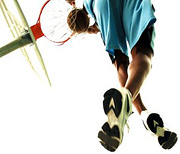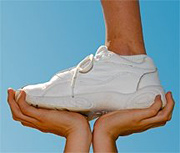It All Starts With Your Feet
By Brian Jensen, DC
Protect Your Foundation Imagine you are a building. The architectural structure of the building is important because it determines if the building will hold up to stress. The same is true for the human body. A balanced structure means a reduced chance of injury and increased endurance. An improvement in your overall structure also improves your athletic performance. It's clear how important it is to take care of your structure - especially your feet.
Your feet are the foundation for your entire body. They must be able to properly support your body; allow you to stand, walk, run, and jump; and absorb damaging shock that enters your body every time your heel hits the ground. Every athlete deals with structural defects, many of which start in the feet.
 Pain tells you to consult your doctor, team physician or trainer. But foot imbalance or dysfunction does not always cause pain just in your feet - the pain may transfer to your lower legs, knees, hips or spine instead. Why? Your body is like a large, interconnected chain; movement at one of your joints affects movement at other joints. If your feet have imbalances or weaknesses, they travel all the way up your body.
Pain tells you to consult your doctor, team physician or trainer. But foot imbalance or dysfunction does not always cause pain just in your feet - the pain may transfer to your lower legs, knees, hips or spine instead. Why? Your body is like a large, interconnected chain; movement at one of your joints affects movement at other joints. If your feet have imbalances or weaknesses, they travel all the way up your body.
If you don't think you have any foot imbalances, think again. Eighty percent of people develop some type of foot imbalance by the age of 20, and virtually everyone has foot imbalances by the age of 40. After years of standing, walking, and wearing shoes, the arches of your feet gradually weaken and are not able to provide the necessary support for your body.
 Pronation, Supination and Proprioception
Pronation, Supination and Proprioception
Pronation (inward rolling of the foot, particularly the heel and arch, as the heel contacts the ground) and supination (the opposite of pronation - outward rolling of the foot as the heel hits the ground) are normal foot movements that occur during walking and running. But when your foot excessively pronates or supinates, it puts the stability of your entire body at risk. These conditions can lead to other forms of an unstable posture, including uneven shoulder heights, one leg that is shorter than the other, and tilting in your hips.

